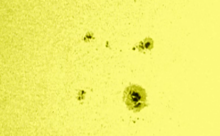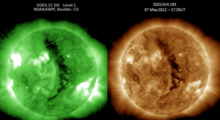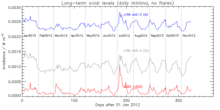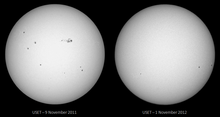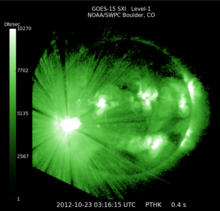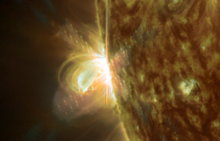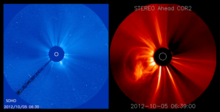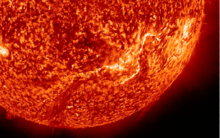news
Submitted on 2012-12-20
With 2012 nearing its end, it may be a good time to have a quick review of some of the more spectacular events that the Sun produced this year. Though Solar Cycle 24 (SC24) certainly has been weak so far, solar activity was quite interesting at times with the Sun producing some truly amazing events.
Submitted on 2012-12-13
Sunspot groups come in a variety of shapes, and it is well known that such regions occasionally team up to form an eye-catching configuration. This was the case late November and the beginning of December, when NOAA 1623 and 1625 formed a nice square of sunspots.
|
Submitted on 2012-12-07
Coronal holes are regions in the hot solar atmosphere ("corona") where the plasma density of that temperature is very low compared to its surroundings, and thus they look like dark shapes in the corona. They are also known to be the source of the high-speed solar wind, and as such can create geomagnetic disturbances when aimed at the Earth. As the larger coronal holes may hold their shape through several solar rotations, they are interesting for long term space weather predictions. |
|
Submitted on 2012-11-29
Last week had a couple of days with increased solar activity. For the period of 20 to 23 November, 4 movies in as many different wavelengths were created showing some impressive dynamics in the Sun's atmosphere. Imagery for these clips was taken from the GONG/H-alpha Networkand from SDO/AIA and HMI.
|
Submitted on 2012-11-10
Once again, last week's activity was not particularly exciting: Just a few small single sunspots, that was it! Also, the SIDC announced that the provisional sunspot number for October was 53.3. That is the lowest since February this year. What a difference with the sunspot activity one year ago: Several groups dotted the solar surface during that November month, and also the biggest sunspot group so far this solar cycle (NOAA 1339) made its appearance. Obviously, one wonders if SC24-maximum has already passed.
Submitted on 2012-11-02
On October 23, active region NOAA1598 produced the 15th X-class flare of the current solar cycle (SC). The X1.8 was of short duration, lasting only 8 minutes. It did not produce an energetic particle event (proton event), and there was no obvious indication of an ejected plasma cloud.

Submitted on 2012-10-25
On 20 October, the Sun unleashed an impulsive M9-flare. This flare peaked at 18:14UT in sunspot group NOAA 1598, which was at the time of the blast still partially behind the southeastern solar limb. One already has to go back to 12 July to find an even stronger flare (X1.4 in NOAA 1520).
The flare did not last long: Starting at 18:05UT, it already had come to its end by 18:19UT. No high-energetic protons were released at the time of the flare, and only a slow and weak coronal mass ejection (CME), directed away from Earth, was associated with it. |
Submitted on 2012-10-18
As discussed in the previous STCE Newsletter, the very Long Duration Event from 5 October propelled a coronal mass ejection (CME) towards Earth. From the SOHO and STEREO imagery, forecasters concluded that this CME would deliver a glancing blow late on 8 October or on 9 October. |
|
Submitted on 2012-10-11
In the morning hours of 5 October, the Sun produced a relatively weak B7.8 flare. Interesting were its atypical x-ray evolution and its very long duration. Indeed, starting at 03:17UT, it reached its maximum x-ray intensity only at 07:30UT. Ending at 10:46UT, the flare lasted for a whopping 7 hours and 29 minutes, and that begged for some closer examination. As it turns out, this was a very complex event. |
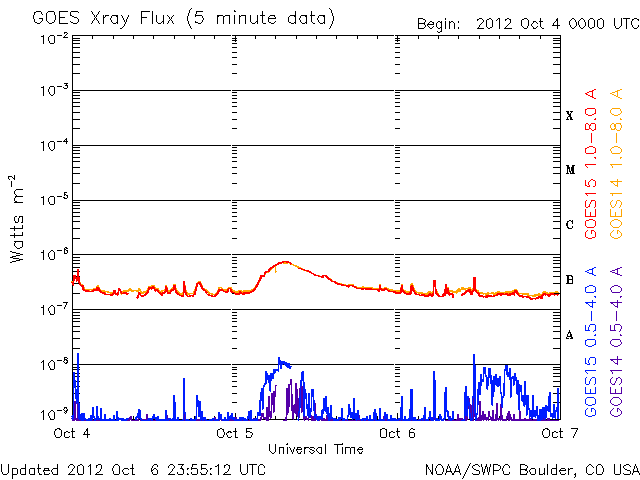 |
|
Pages
Zircon - This is a contributing Drupal Theme
Design by
WeebPal.


